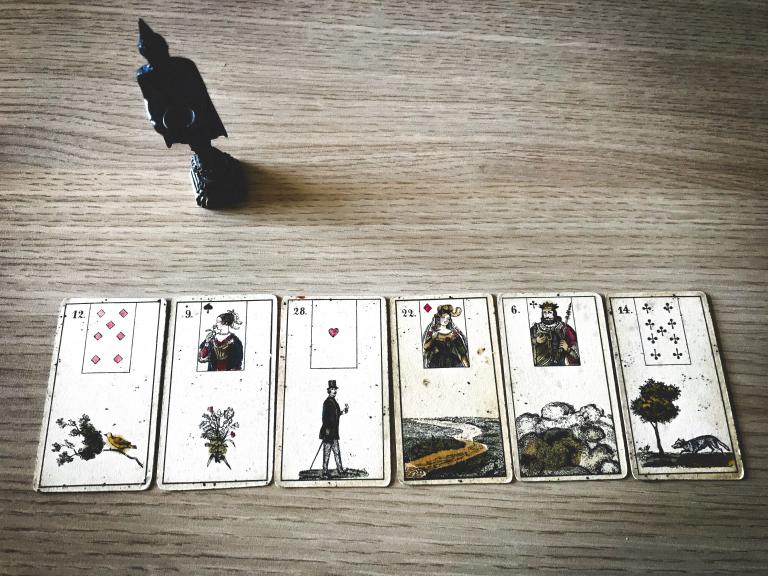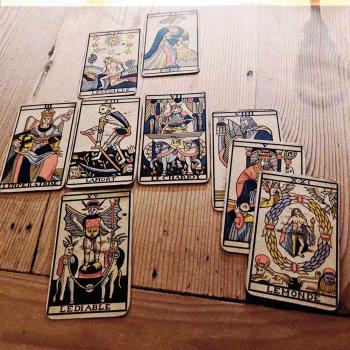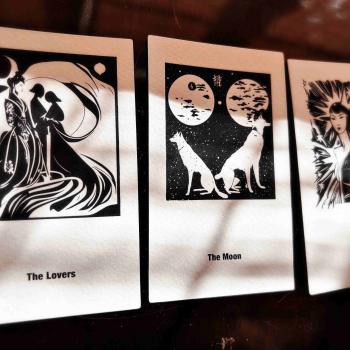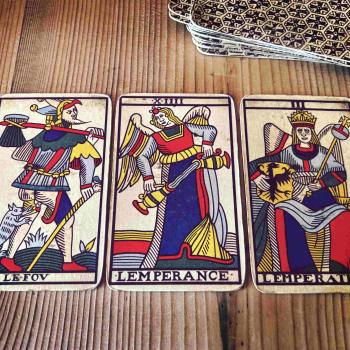The question of direction in cartomancy is often discussed by students and teachers alike, with different schools settling it one way or the other. Do you read from left to right by default, or do you read the direction that the characters depicted on the cards suggest or take?
In principle you can do what you like, if you decide in advance that there’s a particular method you want to follow.
But you can also choose to both use a method and not use a method simultaneously.
I’m thinking of this today, as I find myself answering a question from a student from Israel in the newly formed group in the Lenormand Foundation Course (the course hasn’t started yet, and registration is still open a few more hours, but the interesting questions are already pouring in).
She wanted to know what’s most beneficial, given the fact that she’s used to reading everything from right to left.
I formulated three simple rules that I think others out there may benefit from. This is what I said:
1) You always work with the image first, considering the function of each ‘symbol’ before you decide what the thing ‘means’.
2) You always work with your own cultural conditioning, meaning, if you’re conditioned to read from right to left, then you do that as a matter of course. Here, however, you might consider the Western context and the fact that an illustrator has the opposite cultural conditioning, being inclined to pen the image with a right-forward movement.
3) You always keep a keen eye on the possibility to bust out of your cultural conditioning, or indeed, out of what you take for granted as ‘meaning’, as, ‘it is so because it’s always been so.’
The third key here is the toughest, as you never tend to think of what you’ve internalized as a matter of course, but which has no legitimate ground in any reasonable discourse.
So the art is to keep these three movements in sight when you read the cards, and balance them against each other.
Don’t read from left to right because that’s what you always do, or vice versa. Do it if you have good cause for it, if you see something at the image level that prompts you to do so. That’s your guiding line, not conditioning.
But you need to know how precisely you’re conditioned, because if you don’t, you won’t get that exciting feeling of having transgressed slightly what everyone thinks or says.
The magic is in that transgression, though here you must exercise the art of discernment, for if you go over board with your transgression, then you’re merely ready to meet the mad ones out there.
It’s the same with following lists of meanings for the sake of following, not because it makes sense.
The idea is to familiarize yourself with the mainstream vocabulary, so you’re able to bust the shit out of it.
6 cards moving
I didn’t give an example with the cards in my answer above, as I just wanted to respond promptly.
But what I said gave me an incentive to throw some cards here, and see how we can apply the idea of the three rules.
I put down 6 cards at random, just to see what was happening in terms of reading according to direction.

Birds, Flowers, Man, Crossroads, Clouds, Fox
My preferred style is to read the cards in-line as a sentence. My preferred style is also to always have a question, but this time I had none, as I just wanted to get a sense of the direction of the cards both at image level and at the cultural level:
So let’s try to see some differences:
If we read from left to right we can say this:
Although the news is good, the Man has a dilemma and consequently follows a path that leads to deception.
If we read from right to left we can say this:
Although what you see is not what you get, you can still be fortunate to get a message that’s appreciated across.
Now, if we look at what happens in the cards themselves, without making recourse to any of their added symbolic value, we note the following:
The birds are singing towards the left.
Flowers are static, not ‘going’ or ‘looking’ in any direction than straight at us.
The man clearly makes a walking gesture towards the right, left foot first, getting to the crossroads.
The Crossroads split into two. If this was part of a tableau, we could follow the cards that go up or down from each direction to create a narrative.
There’s fog on the road, what with the clouds as if all over it.
The Fox makes a move to the left.
Now, if we were to take all of this information into account – which we must, otherwise, why read cards at all – then we can advance the following claim, starting with noticing that the Man has his back turned away from the Birds.
Good news is disregarded because someone else more cunning than the birds makes the idea of alternative roads viable.
If this was a question about ambivalence, we’d be prone to rhetorically ask the man we read the cards for: ‘Are you stupid, or something? Why leave the goodwill behind, for the shady business deal? What’s wrong with you?’
It goes to show.
What is most beneficial is to start with the cards, read the damn cards, and forget about what school dictates what direction. Use your own common sense for it.
♠
63 people have joined the Lenormand Foundation Course so far. More are welcome. Registration closes in 6 hours, at 6PM, EST.
















